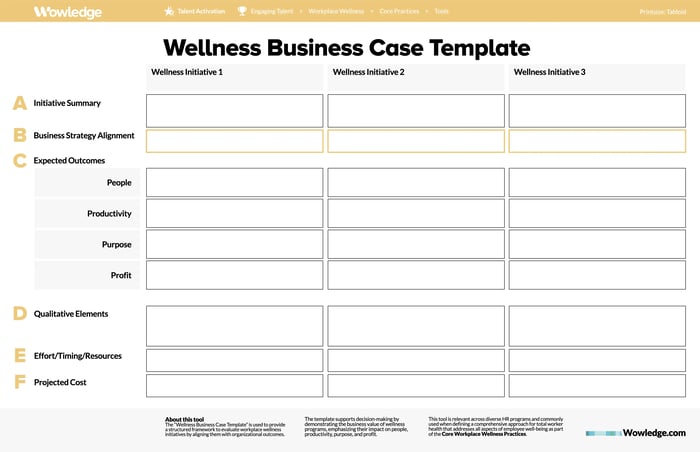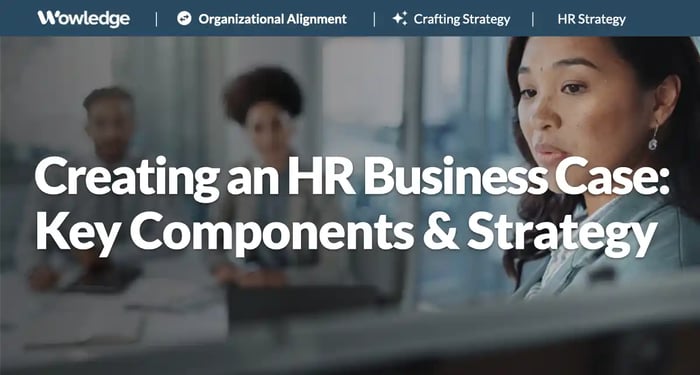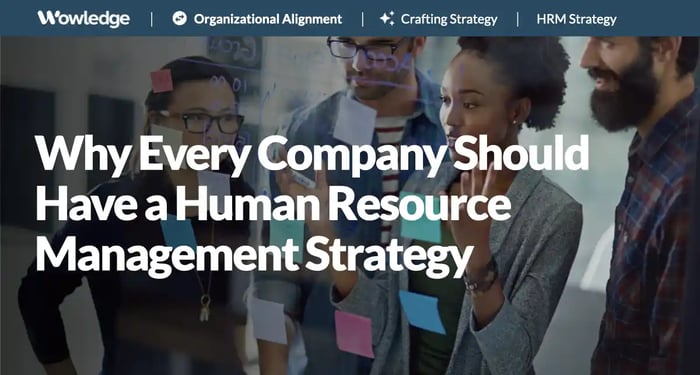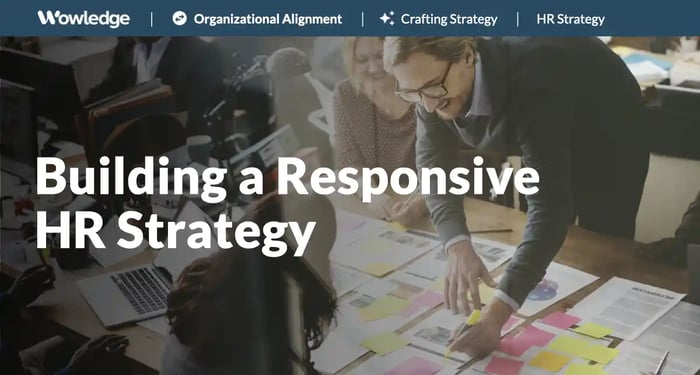Table of Contents
- Understanding the nature of an HR business case
- The benefits of developing an HR business plan
- When to build an HR business case
- Key components of a business case for HR initiatives
- The role of analytics in HR business case development
- The opportunity to partner across the business
- HR business case development for small or lean HR teams
- Relevant Practices & Tools
- About Wowledge
As HR leaders and their teams work every day to communicate their brand and maintain an edge as strategic, business-aligned professionals, the search for high-impact methods and techniques is continuous. While emerging and leading practices often dominate that search, there are well-established tactics and planning methods proven to deliver, including the HR business case.
The HR business case is an effective tool that supports the building of HR credibility, trust, and business alignment. It enables professionals who use these tools to talk to the executives and leaders they support in a language they understand and to act on established plans and actions they themselves use.
An HR business case provides an operational justification for major plans and actions that HR teams identify as beneficial to improved talent and business outcomes, while assessing their feasibility and business value for leadership approval.
Understanding the nature of an HR business case
An HR business case is a specialized version of a common business analysis process and tool that documents the justification for making an investment and/or undertaking a project designed to significantly improve an organization’s operational, financial, or business outcomes. It is used to educate top decision-makers and gain their support for a proposed course of action, such as improving HR or work processes, purchasing new technologies, or making significant changes to HR and talent programs.
As a method commonly used by corporate strategy, finance, marketing, and IT teams, the HR business plan serves as formal documentation of the thinking and rationale related to identifying a problem, its scope and projected impact, reviewing solution options, quantifying their benefits, and proposing a solution in a way that persuades decision-makers to approve and back it. It is a structured analysis that describes a current state and evaluates multiple options leading to a recommended course of action using qualitative and quantitative methods.
The benefits of developing an HR business plan
An HR business plan is designed to educate and raise leadership's awareness, using quantitative methods and a focus on critical outcomes to present a problem-and-solution package that resonates with them and their operational concerns. It leverages a structured, fact- and business-based rationale for a significant change in how the organization operates and achieves its stated objectives, providing justification for the review and action by decision-makers.
It relies on existing (and new) financial, talent, and operational data and metrics to explain how an investment of time, energy, resources, and finances will benefit the organization. As such, it supports quantitative and business-based decision-making about plans and investments.
A business plan establishes a common understanding of the purpose, objectives, value, and solution options, serving as the basis for a logical and comprehensive discussion of the reasons for making an investment, pursuing a project, or following another strategic direction. It provides enough detail to answer likely questions, including alternative courses of action, considerations, and risks associated with a preferred or recommended solution.
The use of an HR business plan also supports the function’s perception as a business-aligned partner by leveraging respected, valued business concepts and processes. The very use of quantitative analyses to generate an objective assessment and understanding of the current state, to assess the operational or financial relevance of the HR-related issue or opportunity, and to model or simulate improved outcomes is noteworthy and attention-getting.
When to build an HR business case
Given the benefits listed above, developing an HR business case represents a valuable investment in the HR leader or team’s time and effort. At a minimum, it should be considered for any proposed activity or initiative that will require a significant redeployment or distraction of a reasonable number of people resources, or represent a significant shift or change in how HR or its client organizations function and perform their work. It can be created in support of a major proposal for functional transformation, reorganization, initiative, system acquisition, or new capability—in HR or elsewhere in the business.
It should be used when a significant investment is required that impacts existing (or expected) budgets, either as redistributions or calls for additional funding. A business case is useful for prioritizing multiple projects or development opportunities, or for evaluating a range of possible solutions. It is highly relevant to proposals for improving HR (e.g., process redesign, team staffing, or resource shifts) or to operational improvements for internal customers (e.g., reorganization, workflow improvements, or team-building interventions).
An HR business case can support initiatives at every level of an organization, large or small. They can be developed by or with a CHRO, an HRBP, HR or COE Manager, HR Generalist, or an HR project team. It is used to develop and communicate a compelling narrative for the business justification related to a change or improvement to decision-makers, including HR leaders, line managers, top executives, and the board of directors.

Key components of a business case for HR initiatives
A classic business case comprises several sections, each building on the others to tell a story in a structured, compelling manner.
1. Provide an overview or executive summary
Explains at a high level the nature of the issue or opportunity, the best solution among several options, and the anticipated return on investment. The business case document opens with an overview that appeals to busy top executives who want to get the context and overarching idea of what is being proposed, why, and how it can be expected to impact a defined set of outcomes.
2. Define the problem
Provide the necessary context by specifying the problem to be resolved or the opportunity to exploit. Use root cause analysis and hypotheses to explain the reasons for the business challenge or gap, such as process inefficiencies, outdated technology, high turnover, legal risks, or a poor strategic alignment. State the problems in terms of operational or financial shortcomings, using internal data on productivity, performance, and behaviors from HR metrics and KPIs, employee listening, as well as business and operational analyses. Calculate the business and lost opportunity costs of the issues and present those as proof of the issue’s importance. Focus on metrics that matter most to the relevant leaders in terms of organizational strategies and operational goals.
3. Identify solution options
Generate a list and analysis of options, alternatives, using external sources of expertise as part of an evidence-based HR (EBHR) approach that uses facts and objectively-based criteria to guide issue definition. Brainstorming sessions with HR experts and line managers are especially effective at generating fresh ideas and opening up the targeted population leaders to new possibilities. Use industry and academic research, benchmarks, opinions, and perspectives to identify well-established and leading-edge solutions to the root causes and to EBHR solution design.
4. Analyze and compare alternatives
An important element of the HR business case is a comparison of potential solutions that demonstrates the range of thinking that went into identifying the most suitable one. The key is to narrow down the options based on criteria to determine the choice—typically, these include cost, time, resource requirements, risks, and expected impact or benefits. These assessments require a listing of each alternative (from doing nothing to making major investments), and articulating their costs vs. benefits in quantitative terms. This will create a feasibility comparison that supports an “apples-to-apples” evaluation of each option. Comparative analyses should include:
- Cost-benefit or ROI calculations compare the total cost of each solution against the projected benefits to calculate a return on investment (ROI). These should include financial (technology, equipment, training) investments and operational (labor, production downtime or delays) costs, as well as reserves needed in case of initiative stretch-out, unforeseen delays, or slow adoption rates.
- Benefits of the future state in terms that will resonate with leadership and the line organizations, such as operational improvements related to processing speed, productivity gains, product or service quality, staffing reductions, or cost avoidance. Analyses that statistically predict gains in business objectives—such as profitability, customer satisfaction and loyalty, revenue growth, and market share—are especially powerful.
- Risk assessments that evaluate the probability and impact of potential risks (e.g., legal, productivity, or financial losses) that could be avoided if each proposed option is undertaken. Include potential failure points, and the steps that should be built into the plan to minimize the likelihood or impact of these occurring. Risk assessments are highly valued when an HR business case involves a large expenditure or organization-wide change in operational management or organizational structure.
5. Propose a solution
An HR business case builds towards a proposed or preferred solution based upon a series of considerations, criteria, and analyses that logically guide decision-makers towards a single conclusion. The preferred solution—whether a reorganization, HR system, HR analytics initiative, or upskilling or reskilling program—specifies how it will most effectively address the issue or opportunity and align with the organization's strategic objectives.
The proposal can be a single project or a multi-phased milestone-based solution that is incremental and manages risks of over-investment or unachievable returns. It should articulate the initiative's vision, goals, and objectives, and explain why the selected option is the best among those presented. It must restate the benefits, both tangible (e.g., time and cost savings, efficiency gains, effectiveness) and intangible (e.g., employee experience, engagement). In other words, it should explain success from the perspective and needs of key stakeholders.
6. Develop a detailed plan
Being able to explain the details of implementing the initiative is essential and anticipates the questions that leaders and other stakeholders will ask. A detailed implementation plan should include activities, timelines, milestones, resource allocation, accountabilities, and responsibilities. A formal change management strategy that is embedded should clearly consider and state how and when the impacted organizations (and their employees) will be engaged, including (ideally) their involvement in solution design, development, adaptation, roll-out, training, support, and evaluation.
7. Define how success will be measured
Using the same criteria, metrics, and analyses used to identify the issue or opportunity, create a dashboard of key performance indicators (KPIs) and analytical methods to evaluate progress towards and the impact of the solution(s) selected for implementation. Leverage these in ongoing communications with stakeholders and use them as benchmarks for evaluating the performance of updated processes, systems, programs, and practices. The most impactful measures will involve a blended analysis of HR and business data that demonstrates the extent to which the initiative or intervention achieved the originally hypothesized impact on operational, business, financial, or talent outcomes.

The role of analytics in HR business case development
The primary value of a business case lies in the clear articulation of its purpose and the problem to be solved, and the proof of its projected value to the organization. The second part of that is often the challenge and reason why many HR professionals shy away from developing one. There is a three-stage process that defines their use of data and measures in the development of an HR business case:
- Quantification of the issue, challenge, or opportunity to be addressed, or current state measurement and analysis of process, behavior, or outputs. (How do we know there is a problem?).
- Using objective means to identify and compare options for change, or internal and external trending and benchmarking of methods and outcomes related to various change options (e.g., What are others doing that is creating the improvements we seek?).
- Assessing the potential to impact the updated or new process, practice, or program, or the projected effect of making investments in technologies, process improvement, or people/skill enhancements (How will we know that our rationale for the change makes (or made) sense?).
Measurement and analysis are used throughout the development of an HR business case and add substantial credibility and confidence to decisions to approve proposed changes. Quantifying the issue can be done using data and trend analyses from HR (turnover, candidate offer acceptances, employee experience) and from business or operational sources (productivity, sales, product quality). Identifying and comparing options can be assessed through measures of high-performing (outlier) team workflows and outputs, competitor benchmarking, or industry research and case studies. Assessing the potential for impact can be conducted using predictive analytics techniques that blend and analyze HR and business data to statistically estimate the likelihood and extent of achievable improvement (e.g., via regression techniques). Each of those can be used as KPIs and analytics to track solution progress, early successes, milestones, and ongoing (post-implementation) success and trends.
The opportunity to partner across the business
There are several benefits to partnering with peers in other company functions, including enhanced credibility on the business case, leveraging advanced financial and operational expertise, and gaining access to data and insights that might otherwise be unavailable or unattainable to the HR professional. Partnering brings together skills and techniques from different functional experts that might not exist within HR. Examples of effective partnerships and the benefits that can be leveraged in the joint development of an HR business case include:
- Finance: access to business, financial, and operational data, and support in the use of advanced statistical techniques.
- Information Technology: access to cross-functional data, data warehouses, and cloud computing environments, integration, and analysis support.
- Marketing or Product Development: business case formatting and development, presentation, promotion.
- Supply Chain and Procurement: access to external experts and resources, external examples of successful implementations, and associated contacts for networking and sharing.
- Business leadership: buy-in, credibility, business alignment, and shared ownership, and championing that naturally arise from the partnership when built in from the beginning and engaged throughout the process.
HR business case development for small or lean HR teams
The level of sophistication described above need not be a barrier to less-resourced HR teams. In fact, for any size organization, the introduction and use of an HR business case can be based upon a simplified framework that establishes a standard and can be adopted across the organization.
Consider the situation of the local HR Manager or Generalist who wants to use an HR business case to build their credibility as a business-aligned partner and works with their peers in Finance and IT to build a solid case for changing the recruiting and hiring process, or the HRBP who needs to assess and compare the options for the reorganization of one of the manufacturing plants they support. In each case, a full-blown case with sophisticated analyses might not be practical, given the scale of the proposed change or the lack of access to the data needed to make such assessments.
The value of an HR business case can still be considerable, given its ability to clearly articulate the problem, response options, and the projected value of implementing selected changes. Case elements are very similar, but can be brought together in a less detailed and abbreviated manner that still communicates critical elements of the proposal, presents options, and answers questions regarding:
- Executive Summary (What needs to be done and how?)
- Problem or opportunity definition and supporting data (What is occurring?)
- Business or operational context (How is this important?)
- Comparative analysis (How can this be addressed?)
- Proposed solution and its benefits (What should be done and why?)
- Analyze costs and ROI (What will this cost and require, and what benefits will it yield?)
Sample HR business case: Wellness solution options

Relevant Practices & Tools
Core HR Practices to Activate the Digital Transformation Journey. >
Digital transformation integrates digital tools, technology, and culture into all aspects of a business, fundamentally altering how an organization operates and delivers value to customers... more »
Laying the Foundation for a DEI Strategy that Aligns with Business Goals and Key Objectives. >
An Employee Value Proposition (EVP) highlights the benefits an employer provides to its workers. While it enables HR work in several ways, an EVP is helpful for defining DEI strategy... more »
Selecting Optimal HR Technologies to Streamline Operations and Improve Talent Outcomes. >
The automation of HR has evolved significantly from its modest start half a century ago with payroll systems to its explosion of HR systems and applications with the availability of mainframes, personal computers, and now, cloud computing and widespread AI capabilities... more »
Assessing Health, Safety, and Wellness Culture to Reduce Injury and Illness Risks and Strengthen Overall Employee Well-being. >
Organizational practices can impact the team's health and wellness beyond team members' behaviors. The global standards for a healthy and safe workplace include identifying and addressing employee health hazards... more »
The Wellness Business Case Template: Capture Analysis and Present Wellness Initiatives Impact and Investment to Secure Leadership Approval. >
This tool offers a structured framework for evaluating and justifying workplace wellness initiatives by aligning them with organizational goals and outcomes... more »
About Wowledge
Wowledge is the implementation-first platform designed for lean HR teams and consultants who need to design and scale strategic HR programs efficiently—without starting from scratch.
Our members gain access to continuously updated best practices, step-by-step guidance, expert-built tools, and customizable templates—all structured to accelerate the development and implementation of key HR programs.
Recognizing that every organization operates at different levels of sophistication, Wowledge’s scalable system of best practices follows a stage-based approach—Core, Advanced, and Emerging—ensuring HR professionals can implement solutions tailored to their organization’s unique needs and goals.
Your Shortcut to Amplifying HR Impact!
Get started for FREE! Learn more.










